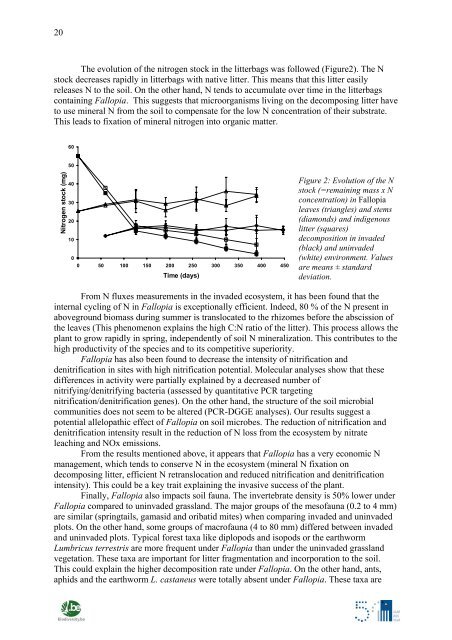Science Facing Aliens - Invasive Alien Species in Belgium - Belgian ...
Science Facing Aliens - Invasive Alien Species in Belgium - Belgian ...
Science Facing Aliens - Invasive Alien Species in Belgium - Belgian ...
You also want an ePaper? Increase the reach of your titles
YUMPU automatically turns print PDFs into web optimized ePapers that Google loves.
20<br />
The evolution of the nitrogen stock <strong>in</strong> the litterbags was followed (Figure2). The N<br />
stock decreases rapidly <strong>in</strong> litterbags with native litter. This means that this litter easily<br />
releases N to the soil. On the other hand, N tends to accumulate over time <strong>in</strong> the litterbags<br />
conta<strong>in</strong><strong>in</strong>g Fallopia. This suggests that microorganisms liv<strong>in</strong>g on the decompos<strong>in</strong>g litter have<br />
to use m<strong>in</strong>eral N from the soil to compensate for the low N concentration of their substrate.<br />
This leads to fixation of m<strong>in</strong>eral nitrogen <strong>in</strong>to organic matter.<br />
Nitrogen stock (mg)<br />
60<br />
50<br />
40<br />
30<br />
20<br />
10<br />
0<br />
0 50 100 150 200 250 300 350 400 450<br />
Time (days)<br />
Figure 2: Evolution of the N<br />
stock (=rema<strong>in</strong><strong>in</strong>g mass x N<br />
concentration) <strong>in</strong> Fallopia<br />
leaves (triangles) and stems<br />
(diamonds) and <strong>in</strong>digenous<br />
litter (squares)<br />
decomposition <strong>in</strong> <strong>in</strong>vaded<br />
(black) and un<strong>in</strong>vaded<br />
(white) environment. Values<br />
are means ± standard<br />
deviation.<br />
From N fluxes measurements <strong>in</strong> the <strong>in</strong>vaded ecosystem, it has been found that the<br />
<strong>in</strong>ternal cycl<strong>in</strong>g of N <strong>in</strong> Fallopia is exceptionally efficient. Indeed, 80 % of the N present <strong>in</strong><br />
aboveground biomass dur<strong>in</strong>g summer is translocated to the rhizomes before the abscission of<br />
the leaves (This phenomenon expla<strong>in</strong>s the high C:N ratio of the litter). This process allows the<br />
plant to grow rapidly <strong>in</strong> spr<strong>in</strong>g, <strong>in</strong>dependently of soil N m<strong>in</strong>eralization. This contributes to the<br />
high productivity of the species and to its competitive superiority.<br />
Fallopia has also been found to decrease the <strong>in</strong>tensity of nitrification and<br />
denitrification <strong>in</strong> sites with high nitrification potential. Molecular analyses show that these<br />
differences <strong>in</strong> activity were partially expla<strong>in</strong>ed by a decreased number of<br />
nitrify<strong>in</strong>g/denitrify<strong>in</strong>g bacteria (assessed by quantitative PCR target<strong>in</strong>g<br />
nitrification/denitrification genes). On the other hand, the structure of the soil microbial<br />
communities does not seem to be altered (PCR-DGGE analyses). Our results suggest a<br />
potential allelopathic effect of Fallopia on soil microbes. The reduction of nitrification and<br />
denitrification <strong>in</strong>tensity result <strong>in</strong> the reduction of N loss from the ecosystem by nitrate<br />
leach<strong>in</strong>g and NOx emissions.<br />
From the results mentioned above, it appears that Fallopia has a very economic N<br />
management, which tends to conserve N <strong>in</strong> the ecosystem (m<strong>in</strong>eral N fixation on<br />
decompos<strong>in</strong>g litter, efficient N retranslocation and reduced nitrification and denitrification<br />
<strong>in</strong>tensity). This could be a key trait expla<strong>in</strong><strong>in</strong>g the <strong>in</strong>vasive success of the plant.<br />
F<strong>in</strong>ally, Fallopia also impacts soil fauna. The <strong>in</strong>vertebrate density is 50% lower under<br />
Fallopia compared to un<strong>in</strong>vaded grassland. The major groups of the mesofauna (0.2 to 4 mm)<br />
are similar (spr<strong>in</strong>gtails, gamasid and oribatid mites) when compar<strong>in</strong>g <strong>in</strong>vaded and un<strong>in</strong>vaded<br />
plots. On the other hand, some groups of macrofauna (4 to 80 mm) differed between <strong>in</strong>vaded<br />
and un<strong>in</strong>vaded plots. Typical forest taxa like diplopods and isopods or the earthworm<br />
Lumbricus terrestris are more frequent under Fallopia than under the un<strong>in</strong>vaded grassland<br />
vegetation. These taxa are important for litter fragmentation and <strong>in</strong>corporation to the soil.<br />
This could expla<strong>in</strong> the higher decomposition rate under Fallopia. On the other hand, ants,<br />
aphids and the earthworm L. castaneus were totally absent under Fallopia. These taxa are


